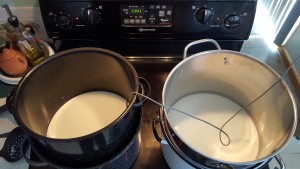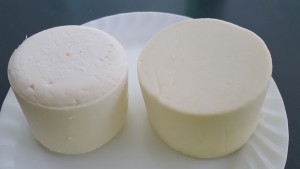I was going through some recipes a friend gave me and came across; “How to make sharp cheddar cheese“, by Ally Heers. Just last week I received two Mesophilic cultures: MM100 and C61 Meso type II, so decided to make this recipe with each culture. Making two cheeses at once keeps you on your toes to make sure the temps are always correct. Below you will find the tweaked recipe and the things I did to make both of the cheeses.
-
1 gallon of whole milk (2 gallons Safeway and Lucerne milk)
-
1/8 tsp mesophilic culture (MM100, C61)
-
1/2 tsp Calcium Chloride
-
1/4 tsp rennet
-
1 tablespoon of salt
- Begin warming milk, add calcium chloride somewhere before 90°. I added at about 86° a few minutes before it reached 90.

- Warm the milk to 90 F using a double boiler. Add 1/8 tsp of mesophilic culture. Allow a couple minutes for the culture to
re-hydrate. Mix thoroughly with a whisk or spoon in an up and down motion, the culture must be distributed evenly throughout the milk. Be careful not to stir it! - Let the milk ripen for 1 hour.
- Put the 1/4 tsp of rennet into 1/4 cup of distilled water at least 20 mins before using. Slowly pour the rennet into the milk over a slotted spoon. Stir constantly in an up and down motion. Stir for several minutes.
- Let the milk set for 1 to 2 hours. After 1 hour, I checked and it was reasonably firm but decided to go for 2 hours to let the flavor develop. Once a firm curd is set and a clean break can be cut, take a long knife and cut the curds into 1/4 inch cubes. (Curd for MM100 firmer)
- Allow the curds to set for 15 minutes.
- Slowly raise the milk to 102° F. It will take 45 minutes to raise the milk to this temperature. While you wait, gently stir the curds occasionally so they do not mat together. Cook the curds at 102° F for another 45 minutes. Keep stirring the curds every few minutes so they do not mat. (Strange thing happened here, I checked the PH, MM100 was a 4.86 and the C61 was PH 6.05)
- Drain the whey by pouring through a cheesecloth lined colander. Do this quickly without letting the curds to mat.
- Put the curds back into the pot at 102 F. Separate any curds that have matted together. Add the tablespoon of salt and stir together. Keep the curds at temperature for 1 hour stirring occasionally. (I stirred every 5 mins, easiest to set a timer. This allowed me to sit most of this hour and not lose track of time.)
- Gently put the curds into your cheesecloth lined mold.
- Press the cheese at about 20 lbs. for 45 minutes. Remove the cheese and flip it. Press the cheese again at about 30 lbs. for 3 hours. Remove the cheese and flip it. Press the cheese for the third time at about 30-40 lbs. for 15 hours. (recipe originally called for 24 hrs but I didn’t want cheese to dry into the cheesecloth also called for more weight in final press.)
- Remove the cheese from the press. Place the cheese on a cheese board and let dry at room temperature for 3 to 5 days. (waiting for it to dry)
- Wax the cheese and age it in your refrigerator for 3 to 24 months. Remember the longer the cheese is aged the sharper it will taste! Every few days flip the cheese.
Make Notes:

The MM100 curd was very creamy with a sweet salty taste sort of like sour cream and it finished with 1.2 lbs of curd after pressing.
The C61 finished pressing with a firmer feel and the curd tasted a bit like a havati. Finished with 1.5 lbs of curd after pressing. Of course I could have my cultures mixed up, so when we taste the cheese, we will have to remake my favorite to try to duplicate.
Update: June or July and beyond.
Leave a Comment